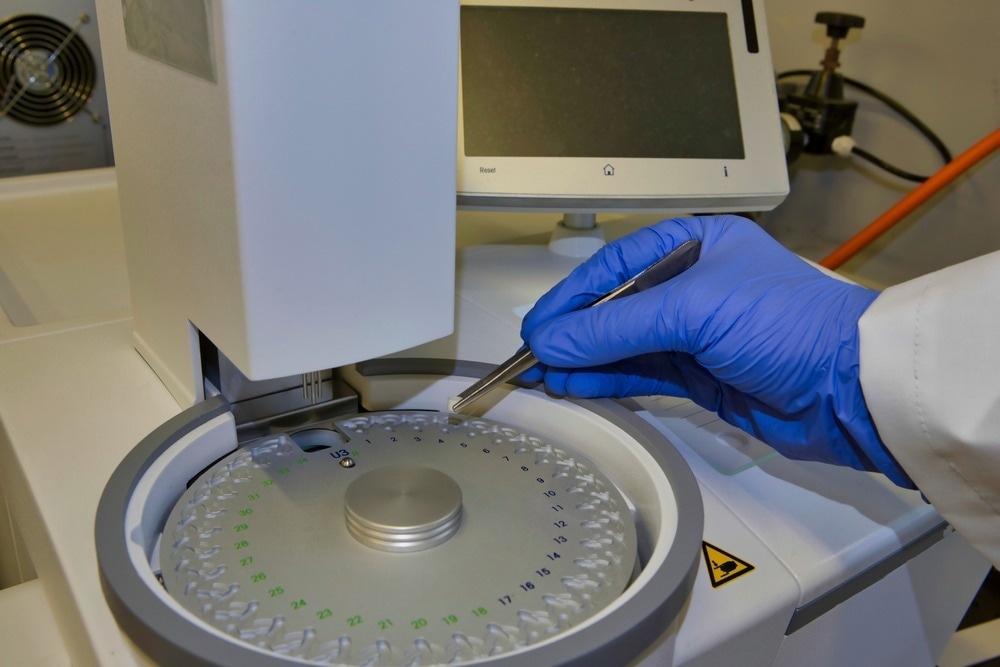 By Taha KhanReviewed by Lexie CornerJul 23 2024
By Taha KhanReviewed by Lexie CornerJul 23 2024Energy storage systems play a critical role in the renewable energy sector by balancing supply and demand and ensuring grid stability. However, it is essential to thoroughly understand and evaluate the materials used in these systems to optimize performance and longevity. Techniques like thermogravimetric analysis (TGA) and differential scanning calorimetry (DSC) fulfill this exact requirement.

Image Credit: Matt_Turner/Shutterstock.com
Understanding TGA and DSC Techniques
TGA measures the change in mass of a sample as a function of temperature or time under a controlled atmosphere, revealing the material's thermal stability, decomposition behavior, and potential for mass loss or gain due to processes like dehydration, oxidation, or evaporation.1
In the context of energy storage, TGA helps identify materials with high thermal stability for enduring repeated charge and discharge cycles and detects decomposition events that could degrade performance or safety.1, 2
DSC, on the other hand, measures the difference in heat flow between a sample and an inert reference material as a function of temperature, providing information on the energy absorbed or released during phase transitions such as melting, crystallization, or chemical reactions.
DSC helps determine the enthalpy associated with phase changes, which is critical for calculating the energy storage capacity of a material. It can also identify the temperature range over which the phase change occurs, helping to optimize operating conditions.2, 3
Enhancing Energy Storage Performance
TGA and DSC help identify and optimize materials for energy storage systems by analyzing thermal stability, decomposition temperatures, and phase transitions. For example, in battery technology, TGA can assess the thermal stability of electrolytes, while DSC can identify phase transitions in electrode materials, aiding in selecting components that enhance performance and safety.4, 5
For instance, in a 2020 study, researchers focused on enhancing the consistency and reliability of measuring thermo-physical properties of phase change materials (PCM) for thermal energy storage systems. They utilized DSC and TGA to develop standardized measurement procedures.6
They measured 23 PCM, achieving high accuracy and precision, with a mean coefficient of variation for key properties such as enthalpy and melting onset temperatures as low as 1.69 % and 0.05 %, respectively. This approach streamlines the selection process for PCM, ensuring better comparability and performance in energy storage applications.6
Discover More: Accelerated Analysis of Pharmaceutical Compounds Using Simultaneous TGA-DSC
TES Characteristics via DSC
In another 2020 study, researchers used DSC to explore the thermal-energy storage (TES) characteristics of various phase change materials. They analyzed three paraffin-based PCMs and one bio-based PCM, focusing on their melting temperatures, sensible heat storage capacities, and latent heat enthalpies.7
The study employed both classical dynamic DSC and a stepwise approach to minimize measurement errors due to sample size, heating rate, and thermal conductivity. The results showed that while both types of PCMs had similar TES capacities, bio-based PCMs had a narrower phase change temperature range.
This indicates that bio-based PCMs could be a viable, environmentally friendly alternative for building applications. The study highlights the effectiveness of DSC in characterizing PCMs for TES, which is crucial for developing efficient and sustainable energy storage solutions.7
Challenges and Considerations
Although TGA and DSC are powerful tools, their application in material evaluation for energy storage faces certain challenges. For instance, TGA and DSC results are highly sensitive to sample preparation methods, and variations in particle size, sample amount, or presence of impurities can significantly impact the data.2
Interpreting the data can be complex, especially when dealing with materials that undergo multiple overlapping transitions or reactions. To overcome these challenges, researchers focus on improving the accuracy, reproducibility, and scalability of TGA and DSC techniques by developing standardized protocols for sample preparation and data analysis, ensuring result consistency across different studies.
New instrumentation advancements, such as high-resolution TGA and modulated DSC, provide improved sensitivity and allow for detailed analysis of complex materials.3, 8
Future Outlooks
Continuous advancements in TGA and DSC indicate that these evaluation techniques will significantly advance energy storage systems. In the near future, advances in instrumentation, such as real-time data acquisition and enhanced sensitivity, can improve the accuracy and resolution of these techniques.
Incorporating TGA and DSC with other analytical methods, such as spectroscopy and microscopy, will provide a deeper understanding of material properties. Similarly, integrating TGA and DSC data with computational modeling tools will enable researchers to predict and design materials with tailored thermal properties for specific energy storage applications. Automation and high-throughput analysis capabilities can also accelerate the screening and optimization of new energy storage materials.
Ongoing research and development in TGA and DSC, coupled with advancements in other material characterization techniques, will help researchers design next-generation materials with superior performance, leading to efficient and reliable energy storage systems.
More from AZoM: Bio-based Polyethylene: A Sustainable Solution for Plastic Waste
References and Further Reading
- Saadatkhah, N., et al. (2020). Experimental methods in chemical engineering: Thermogravimetric analysis—TGA. The Canadian Journal of Chemical Engineering. doi.org/10.1002/cjce.23673
- Lager, D., Hohenauer, W., Knoll, C., Weinberger, P., Werner, A. (2018). Methodology to determine the apparent specific heat capacity of metal hydroxides for thermochemical energy storage. Journal of Thermal Analysis and Calorimetry. doi.org/10.1007/s10973-017-6883-2
- Fatahi, H., Claverie, J., Poncet, S. (2022). Thermal characterization of phase change materials by differential scanning calorimetry: A review. Applied Sciences. doi.org/10.3390/app122312019
- Röder, P., Baba, N., Wiemhöfer, HD. (2014). A detailed thermal study of a Li [Ni0. 33Co0. 33Mn0. 33] O2/LiMn2O4-based lithium ion cell by accelerating rate and differential scanning calorimetry. Journal of Power Sources. doi.org/10.1016/j.jpowsour.2013.09.146
- Lee, HJ., et al. (2012). Application of TGA techniques to analyze the compositional and structural degradation of PEMFC MEAs. Polymer degradation and stability. doi.org/10.1016/j.polymdegradstab.2012.03.016
- Müller, L., Rubio-Pérez, G., Bach, A., Muñoz-Rujas, N., Aguilar, F., Worlitschek, J. (2020). Consistent DSC and TGA methodology as basis for the measurement and comparison of thermo-physical properties of phase change materials. Materials. doi.org/10.3390/ma13204486
- Nazari Sam, M., Caggiano, A., Mankel, C., Koenders, E. (2020). A comparative study on the thermal energy storage performance of bio-based and paraffin-based PCMs using DSC procedures. Materials. doi.org/10.3390/ma13071705
- Ferrer, G., Barreneche, C., Solé, A., Martorell, I., Cabeza, L. F. (2017). New proposed methodology for specific heat capacity determination of materials for thermal energy storage (TES) by DSC. Journal of Energy Storage. doi.org/10.1016/j.est.2017.02.002
Disclaimer: The views expressed here are those of the author expressed in their private capacity and do not necessarily represent the views of AZoM.com Limited T/A AZoNetwork the owner and operator of this website. This disclaimer forms part of the Terms and conditions of use of this website.